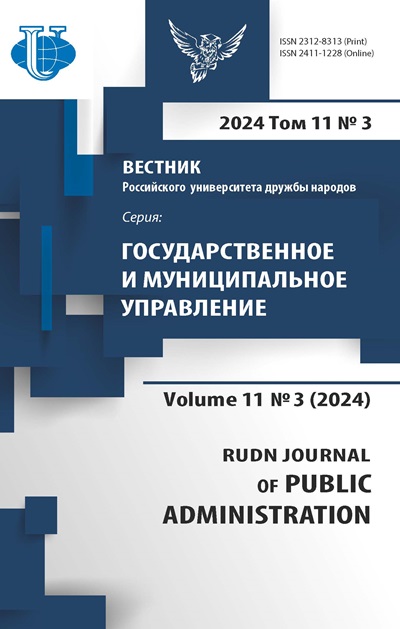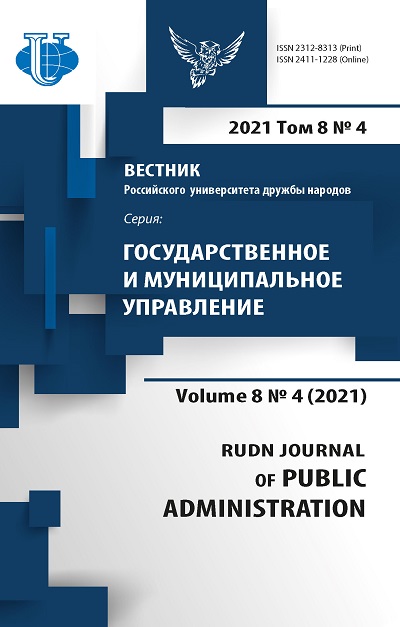Совместное управление и местное экономическое развитие в отдельных малых городах: на примере провинции Западный Кейп, Южная Африка
- Авторы: Камара Р.Д.1
-
Учреждения:
- Стелленбошский университет
- Выпуск: Том 8, № 4 (2021)
- Страницы: 405-422
- Раздел: МЕЖДУНАРОДНЫЙ ОПЫТ ГОСУДАРСТВЕННОГО УПРАВЛЕНИЯ
- URL: https://journals.rudn.ru/public-administration/article/view/29649
- DOI: https://doi.org/10.22363/2312-8313-2021-8-4-405-422
Цитировать
Полный текст
Аннотация
В статье представлены результаты исследования, основанного на анализе совместного управления и местого экономического развития в отдельных небольших городах провинции Западный берег (ЮАР). В работе отмечается отсутствие интеграционной институциональной основы для содействия совместному участию, что отрицательно влияет на способность местных муниципалитетов успешно управлять местное экономическое развитие (МЭР) совместно с соответствующими заинтересованными сторонами. Содействие такому инклюзивному представительству и участию всех заинтересованных сторон обеспечивает альтернативу традиционному бюрократическому механизму управления. В исследовании изучались конкретные факторы, влияющие на разработку и внедрение совместного управления для МЭР в выбранных сопоставимых муниципалитетах провинции. В частности, исследование направлено на определение факторов, влияющих на успешное функционирование кооперативного управления, направленного на продвижение местного экономического развития в рассмотренных муниципалитетах. Данные были собраны с помощью трех методов, а именно: обзор документов, интервью и обсуждение в фокус-группах. Исследование вносит вклад в совокупность знаний о совместном управлении, определяя конкретные факторы данного подхода, обеспечивающие эффективность управления МЭР в малых городах и способность муниципалитетов успешно управлять местным экономическим развитием совместно с соответствующими заинтересованными сторонами. Углубленное понимание взаимосвязи и динамики этих переменных помогает предложить рекомендации о том, как улучшить качество управления и реагировать на социально-экономические проблемы в муниципалитетах за счет улучшения управления в рамках МЭР.
Об авторах
Ричард Д. Камара
Стелленбошский университет
Автор, ответственный за переписку.
Email: dougrichy@gmail.com
ORCID iD: 0000-0003-1153-9215
доктор философии
7602, ЮАР, Западный берег, СтелленбошСписок литературы
- Nel E. Local Economic Development: A Review and Assessment of its Current Status in South Africa. Urban studies. 2001;38(7):1003-1024.
- Nel E.L., Hill T.R., Goodenough C. Multi-stakeholder Driven Local Economic Development: Reflections on the Experience of Richards Bay and the uMhlathuze Municipality. Urban Forum Springer Netherlands. 2007;18(2):31-47.
- Beyer A., Claire P., Anita S. The Role of Participation and Partnerships in Local Economic Development in Africa. New York: New York University’s Robert Wagner Graduate School of Public Service; 2003.
- Kamara R.D. Capacity Building for Local Economic Development: An Evaluation of Training Initiatives in the Cape Winelands District. Diss. Nelson Mandela: Metropolitan University; 2015.
- Phago K. Reengineering and Rethinking Municipal Service Delivery Through Local Economic Development (LED) Initiatives. Conference Paper presented at the 5th annual conference of SAAPAM held in Port Elizabeth; 2004.
- Seduma M.P. The Impact of Local Economic Development on the Livelihood of Communities in Ba-Phalaborwa Municipality. Mopani District, Limpopo Province: South Africa; 2011.
- Hofisi C. Scoring Local Economic Development Goals in South Africa: Why Local Government is Failing to Score. Mediterranean Journal of Social Sciences. 2013;4(13):591-595.
- Bristow G., Adrian H. Building Resilient Regions: Complex Adaptive Systems and the Role of Policy Intervention. Raumforschung und Raumordnung. 2014;72(2):93-102.
- World Bank Increasing the Effectiveness of Multi-stakeholder Initiatives through Active Collaboration. In Governance Working Paper WP1314. World Bank Publications; 2014.
- Adger W.N. Social and Ecological Resilience: Are They Related?. Progress in Human Geography. (2000); 24(3):347-364.
- Hill E., Howard W., Harold W. Exploring Regional Economic Resilience. Working paper No. 04; 2008. doi: 10.13140/RG.2.1.5099.4000
- Chen B. Antecedents or Processes? Determinants of Perceived Effectiveness of Interorganizational Collaborations for Public Service Delivery. International Public Management Journal. 2010;13(4):381-407.
- Ales M.W. Developing and Implementing an Effective Framework for Collaboration: The Experience of the CS2day Collaborative. Journal of Continuing Education in the Health Professions. 2011;13(1):13-20.
- Bryson J.M., Barbara C.C., Melissa M.S. Designing and Implementing Cross-sector Collaborations: Needed and Challenging. Public Administration Review. 2015;75(5):647-663.
- Olson C.A., Jann T.B., George C.M. Factors Contributing to Successful Interorganizational Collaboration: The Case of CS2day. Journal of Continuing Education in the Health Professions. 2011;31(1):3-12.
- Franco M. Determining Factors in the Success of Strategic Alliances: an Empirical Study Performed in Portuguese Firms. European Journal of International Management. 2011;5(6):608-632.
- Emerson K., Tina N., Stephen B. An Integrative Framework for Collaborative Governance. Journal of Public Administration Research and Theory. 2021;22(1):1-29.
- O’Leary R., Yujin C., Catherine M.G. The Skill Set of the Successful Collaborator. Public Administration. 2012;72(1):70-83.
- Kożuch B., Katarzyna S. Factors of Effective Inter-organizational Collaboration: a Framework for Public Management. Transylvanian Review of Administrative Sciences. 2016;47(4):97-155.
- Ysa Tamyko., Vicenta S., Marc E. Determinants of Network Outcomes: The Impact of Management Strategies. Public Administration. 2014;92(3):636-655.
- Dhanpat N., René V.W., Debbie R. Validation of the Thomson, Perry and Miller (2007) Collaboration Instrument in the South African Context. SA Journal of Human Resource Management. 2017;15(1):1-11.
- Thomson A.M., James L.P., Theodore K.M. Linking Collaboration Processes and Outcomes: Foundations for Advancing Empirical Theory. Big Ideas in Collaborative Public Management. Routledge; 2014:107-130.
- Kamara R.D. Creating Enhanced Capacity for Local Economic Development (LED) through Collaborative Governance in South Africa. Socio Economic Challenges. 2017;1(3):98-115.
- Provan K.G., Patrick K. Modes of Network Governance: Structure, Management, and Effectiveness. Journal of Public Administration Research and Theory. 2018;18(2):229-252.
- Bryson J.M., Barbara C.C., Melissa M.S. The Design and Implementation of Cross-Sector Collaborations: Propositions from the Literature. Public Administration Review. 2006;66(1):44-55.
- Davies B. Communities of Practice: Legitimacy not Choice. Journal of Sociolinguistics. 2005;9(4):557-581.
- Babbie E., Johann M. The Practice of Social Research: South African Edition. Cape Town: Oxford University Press Southern Africa; 2001.
- Denzin N.K., Lincoln Y.S. Introduction: The Discipline and Practice of Qualitative Research. Strategies of Qualitative inquiry Sage Publications. 2008;1:1-43.
- Esterberg K.G. Qualitative Methods in Social Research. Boston, Texas: McGrawn Hill Companies; 2002.
- Jones S.R. (Re) Writing the Word: Methodological Strategies and Issues. Qualitative Research. Journal of College Student Development. 2002;43(4):461-473.
- O’leary R., Nidhi V. Collaborative Public Management: Where Have We Been and Where Are We Going? The American Review of Public Administration. 2021;42(5):(2)507-522.
- Eden C., Chris H. The Negotiation of Purpose in Multi-organizational Collaborative Groups. Journal of Management Studies. 2001;38(3):373-391.
- Mattessich P.W., Barbara R.M. Collaboration: What Makes it Work. A Review of Research Literature on Factors Influencing Successful Collaboration. Amherst H. Wilder Foundation, 919 Lafond, St. Paul, MN 55104; 1992.
- Mattessich P.W., Marta M., Barbara R.M. The Wilder Collaboration Factors Inventory: Assessing your Collaboration’s Strengths and Weaknesses. Fielstone Alliance; 2001.
- Coe B.A. Open Focus: Implenenting Projects in Multi-organizational Settings. International Journal of Public Administration. 1988;11(4):503-526.
- Hardy B., Adrian T., Gerald W. Innovations in Community Care Management: Minimising Vulnerability. Aldershot, England: Brookfield, Vt.: Ashgate Publishing; 1992.
- Cepiku D. Network Performance: Toward a Dynamic Multidimensional Model. Network Theory in the Public Sector. 2013;1:188-204.
- Agranoff R., Michael M. Big Questions in Public Network Management Research. Journal of Public Administration Research and Theory. 2001;11(3):295-326.
- Crosby B.C., John M.B. A Leadership Framework for Cross-sector Collaboration. Public Management Review. 2005;7(2):177-201.
- Vangen S., Diamond J., Keynes M. Researching Leadership for Collaborative Advantage. Methdological Challenges in Collective Leadership Research. NY: 3rd Collective leadership workshop; 2016.
- Ospina S., Georgia S. A Constructionist Lens on Leadership: Charting New Territory. The Quest for a General Theory of Leadership. 2006;1:188-204.
- Ospina S.M., Angel S. Paradox and Collaboration in Network Management. Administration & Society. 2010;42(4):404-440.
- Huxham C., Siv V. Working Together: Key Themes in the Management of Relationships Between Public and Non-profit Organizations. International Journal of Public Sector Management. 1996;9(7):5-17.
- Huxham C., Siv V. Managing to Collaborate: The Theory and Practice of Collaborative Advantage. Routledge; 2013.
- Keast R., Myrna P.M. A Composite Theory of Leadership and Management: Process Catalyst and Strategic Leveraging - Theory of Deliberate Action in Collaborative Networks. Network Theory in the Public Sector. Routledge; 2013.
- Bolden R. What is Leadership? Centre for Leadership Studies: University of Exeter; 2004.
- Kickert W.J., Erik-Hans K., Joop F.Ko., et. al. Managing Complex Networks: Strategies for the Public Sector. Sage; 1997.
- Cepiku D., Filippo G. Co-Production in Developing Countries: Insights from the Community Health Workers Experience. Public Management Review. 2014;16(3):317-340.
- Provan K.G., Patrick K. Modes of Network Governance: Structure, Management, and Effectiveness. Journal of Public Administration Research and Theory. 2008;18(2):229-252.
- Klijn E., Jurian E., Bram S. Trust in Governance Networks: Its Impacts on Outcomes. Administration & Society. 2010;42(2):193-221.
- McGuire M. Managing Networks: Propositions on what Managers Do and why They Do It. Public Administration Review. 2002;62(5):599-609.
- Agranoff R. Collaborating to Manage: A Primer for the Public Sector. Georgetown University Press; 2012.
- Koppenjan J., Erik-Hans K. What Can Governance Theory Learn from Complexity Theory? Mirroring Two Perspectives. Routledge; 2013.
- Pethe A., Sahil G., Vaidehi T. Assessing the Mumbai Metropolitan Region: A Governance Perspective. Economic and Political Weekly. 2011;46(26-27):187-195.
- O’Toole L.J., Kenneth J.M. Public Management in Intergovernmental Networks: Matching Structural Networks and Managerial Networking. Journal of Public Administration Research and Theory. 2004;14(4):469-494.
- Sørensen E., Jacob T. Introduction: Collaborative Innovation in the Public Sector. The Innovation Journal. 2012;17(1):1-14.
- Sørensen E., Jacob T. Enhancing Public Innovation through Collaboration, Leadership and New Public Governance. New Frontiers in Social Innovation Research. London: Palgrave Macmillan; 2015.
- Raab J., Patrick K. Heading toward a Society of Networks: Empirical Developments and Theoretical Challenges. Journal of Management Inquiry. 2009;18(3):198-210.
- Lewis V.A., et al. The New Frontier of Strategic Alliances in Health Care: New Partnerships under Accountable Care Organizations. Social Science & Medicine. 2017;190:1-10.
- Liu T., Chia-Chen K. Reducing Agency Problem and Improving Organizational Value-Based Decision-Making Model of Inter-Organizational Strategic Alliance. Computational Economics: A Perspective from Computational Intelligence. IGI Global. 2006;1:290-307.
- Gazley B., Jeffrey L.B. The Purpose (and Perils) of Government-nonprofit Partnership. Nonprofit and Voluntary Sector Quarterly. 2007;36(3):389-415.
- Kucharska W. Relationships between Trust and Collaborative Culture in the Context of Tacit Knowledge Sharing. Journal of Entrepreneurship, Management and Innovation. 2017;13(4):61-78.
- Martín-Rodríguez L.San, et al. The Determinants of Successful Collaboration: A Review of Theoretical and Empirical Studies. Journal of Interprofessional Care. 2005;19(1):132-147.
- Klijn E., Bram S., Jurian E. The Impact of Network Management on Outcomes in Governance Networks. Public Administration. 2010;88(4):1063-1082.
















